Explore this workout:
| Upper-Body Push Workout | Lower-Body Push-and-Pull Workout |
Welcome to one of the most contentious debates in fitness circles: whether it’s best to do split training — dedicating one session to your legs and the next to “bi’s and tri’s,” for example — or full-body training, which prioritizes efforts that address multiple body parts and movement patterns in one session.
Split training typically modifies a conventional strength program by targeting specific muscle groups (such as upper or lower body) or movement patterns (push versus pull) on separate days.
In contrast, full-body training addresses the whole body in every workout session.
As the popularity of functional, full-body training has grown in recent years, split training has been increasingly — and, some would say, unfairly — dismissed by its critics as nonfunctional. But many experts, including Life Time strength coach Nick Sandoval, NASM, NCSF, NESTA, contend that each training style has its place and can lead to transformational results in health and performance.
Why Split Your Routine
By training certain muscle groups and movement patterns on different days, “a split program allows for optimal training volume and also allows each of the groups a chance for full recovery to ensure peak muscle strength and growth,” explains Sandoval.
For those reasons, split training may be particularly suitable for exercisers looking to maximize strength gains; those seeking body recomposition (increased muscle mass and decreased body fat); and athletes who need to plan their strength training around sport-specific workouts and competitions.
“A split program allows for optimal training volume and also allows each of the groups a chance for full recovery to ensure peak muscle strength and growth.”
People who are short on time per workout often prefer split training, too, because each session is typically shorter than a full-body session, says Sandoval.
Split training often requires working out at least four days a week to hit all muscle groups and movement patterns (upper-body push and pull days, lower-body push and pull days).
Not tending to all these elements can result in muscle imbalances. “People often train muscles they can see — the chest, shoulders, arms, and quads — more than muscles they can’t see, like the back, hamstrings, glutes, and calves,” he explains.
For folks who like the structure of working out most days of the week, this aspect of split training is often desirable.
But for those who have limits on the number of days they can (or want to) strength train, split training may not be the best option. Full-body regimens are great for people who have only two or three days per week to train but can devote more time per session.
Ready to give split training a try? “My favorite approach is a four-day split consisting of days focusing on the lower body, upper-body pushing, upper-body pulling, and total-body strength movements — with three days of recovery throughout the week,” says Sandoval.
He offers two sample workouts to be performed on different days.
Upper-Body Push Workout
This upper-body workout focuses on the push movement pattern.
Instructions:
- Perform four straight sets of 12 to 15 reps of each movement (per side, as applicable) before moving on to the next exercise.
- Rest for up to three minutes between sets.
1. Barbell Bench Press

- With either a full squat rack or bench-press-specific bench and rack, set the barbell at an appropriate height so you can unload the bar from the hooks while lying down on a flat bench.
- While seated, set your feet, then lie back so your shoulders and head are on the bench. Allow your upper back to arch away from the bench as you squeeze your glutes and brace your abs to protect your lower back.
- Take a wide grasp on the bar so your wrists are stacked over your elbows in the bottom position (bar rested on your chest). It may take a few sets to get this right.
- Unrack the bar from the hooks. Pull the bar down to your chest, directly across the nipple line or slightly below the sternum. Your shoulders should not hike up in this position.
- Eliminate any bouncing or heaving off the chest by bringing the bar to a half-second standstill on your chest before you initiate the press.
- After a brief pause, press the bar back over your chest. The bar path should be straight and stable in each rep and through the entire set. Repeat for 12 to 15 reps reps.
(For more, see “BREAK IT DOWN: The Bench Press“.)
2. Barbell Shoulder Press
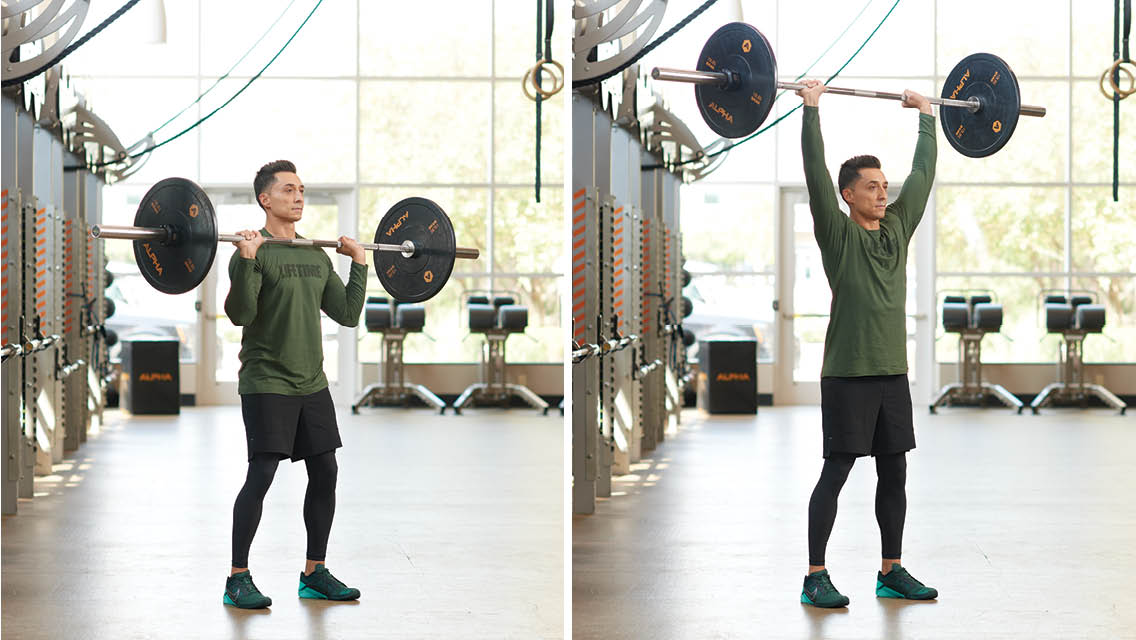
- Place a barbell in a rack at shoulder height. Load it with an appropriate weight (or, if you’re a beginner, use just the bar with no added weight) and stand facing it.
- Assume an overhand grip and step close to the bar, allowing it to sit across your chest, on the front of your shoulders. With feet about hip width apart, lift the bar up and step away from the rack.
- Widen or narrow your grip to find a comfortable position. Keep your elbows close to your body to protect wrists and shoulders. Stack your shoulders over your hips, drawing your shoulder blades back and down.
- Brace your core and glutes and, with control, press the barbell straight overhead, moving your chin out of the way.
- Once your arms are straight overhead, reverse the movement and slowly lower the bar back to your chest. Repeat for 12 to 15 reps.
3. Alternating Dumbbell Chest Press

- Grasping a set of dumbbells, lie back on a flat bench and position the weights at chest-level.
- Press one dumbbell straight up toward the ceiling. After a brief pause, lower the weight back to chest-level.
- Repeat, this time pressing the opposite weight.
- Continue in this fashion, alternating sides for the desired number of reps.
4. Incline Dumbbell Chest Press
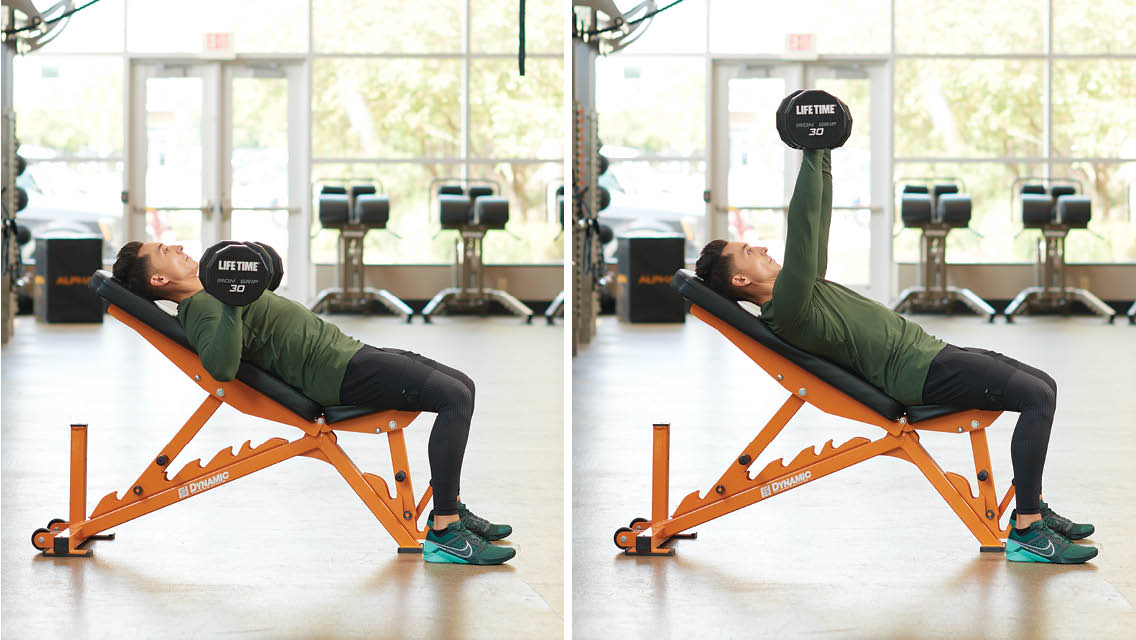
- Using an adjustable bench, position the back so it’s inclined slightly — about 15 degrees; or, depending on the bench, one to two notches up from the bottom. (You can also elevate one end of a freestanding bench using bumper plates if an incline bench is not available.)
- Sitting on the bench seat, hold two dumbbells in front of you, resting them against your thighs.
- Lie back, bringing the dumbbells to the bottom position of the bench press, so your upper arms are at the sides of your chest. Press your feet into the floor and arrange your hands in the most comfortable position for you: Palms can be facing inward in a neutral grip or forward, toward your feet.
- Press the weight straight up over your chest until your arms are fully extended above your sternum. Repeat for 12 to 15 reps.
5. Standing Cable Chest Fly
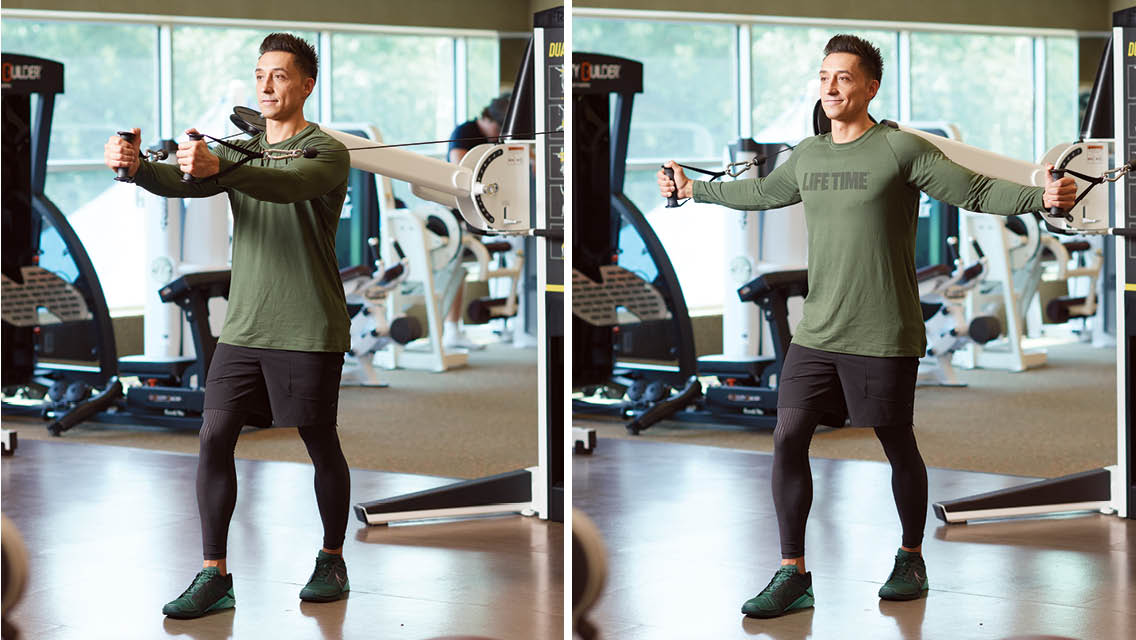
- Position the arms of a dual-cable machine at (or slightly above) shoulder height and just outside of shoulder width horizontally. Secure the handle attachments and select the desired weight.
- Grasp both handles and press them out straight in front of you, palms facing in and elbows slightly bent. (You can take a step forward to split your stance, if that is more comfortable than standing with your feet parallel and shoulder width apart.)
- Keeping a slight bend in the elbows, slowly allow the arms to open wide. You’ll feel a stretch across your chest.
- Return to the starting position by bringing the handles together at chest height. Imagine you’re hugging a tree.
- Repeat for 12 to 15 repetitions.
6. Cable Triceps Extension With Rope

- Begin by securing the rope attachment to a cable machine and adjusting the starting position of the cable to be at the highest point.
- Face the cable machine with your feet shoulder width apart, holding one end of the rope in each hand with your palms facing in, elbows bent at your sides, and hands directly in front of your shoulders.
- Keeping your torso still and your elbows at your sides, push the rope and cable down, extending your arms down to just outside of your thighs with your palms facing backwards. Ensure your shoulders are back and do not round forward. The movement should stretch out the rope horizontally.
- Return to the starting position.
- Repeat for 12 to 15 repetitions.
Lower-Body Push-and-Pull Workout
This lower-body routine combines push and pull movement patterns.
Instructions:
- Perform four straight sets of 12 to 15 reps of each movement before moving on to the next exercise.
- Rest for up to three minutes between sets.
1. Barbell Back Squat

- Inside a squat rack, position the barbell on your upper traps, just below the bony part of the back of your neck.
- Positioned directly under the bar, stand up with the weight and then, taking small steps, back up until you’ve cleared the hooks.
- Initiate the squat by pushing your butt backward and bending your knees.
- Keeping your torso upright, your spine neutral, and your knees in line with your toes, lower yourself as far as you are comfortably able. (If it’s not far, adjust your foot position and try turning your toes slightly outward, but don’t go farther than is comfortable.)
- As you descend, keep your knees tracking in the same direction as your feet, then push off the floor to stand to a full lockout.
- Return to the starting position and repeat for 12 to 15 reps.
2. Dumbbell Romanian Deadlift

- Stand tall and grasp one dumbbell in each hand so they hang down in front of you against your thighs.
- Maintaining a flat back and a slight bend in the knees, hinge at the hips and allow the dumbbells to trail down the front of your legs, keeping them as close to your body as possible.
- When you reach the end of the range of motion — typically felt as a stretch in the hamstrings or a change in back position — reverse the movement and stand up.
- Repeat for 12 to 15 repetitions.
(For more, see “BREAK IT DOWN: The Romanian Deadlift“.)
3. Plate-Loaded Machine Leg Press
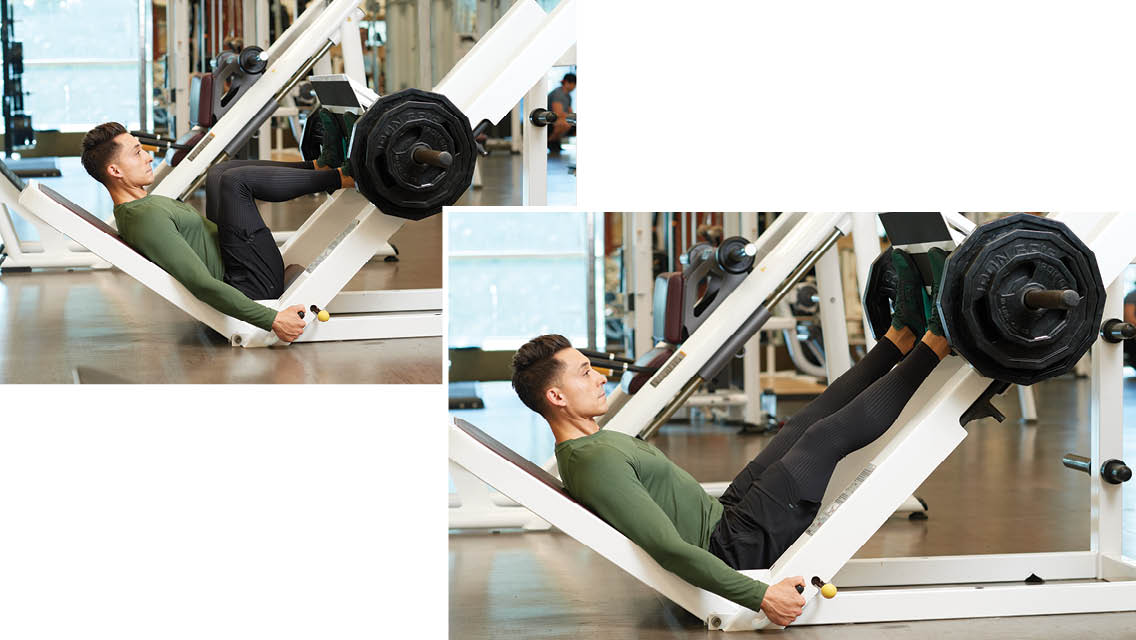
- Set up a plate-loaded (not cable) leg-press machine and sit down with your back against the seat. Place your feet about hip- to shoulder-width apart in the center of the platform.
- Keeping your core engaged, feet flat, and butt on the seat, press the weight away from you, keeping your knees tracking with your toes. Fully extend your knees but be careful not to lock them out completely.
- Pause for a moment, then slowly reverse the movement to lower the weight with control. Keep your feet flat and your lower back in contact with the seat.
- Repeat for 12 to 15 reps.
4. Dumbbell Goblet Reverse Lunge
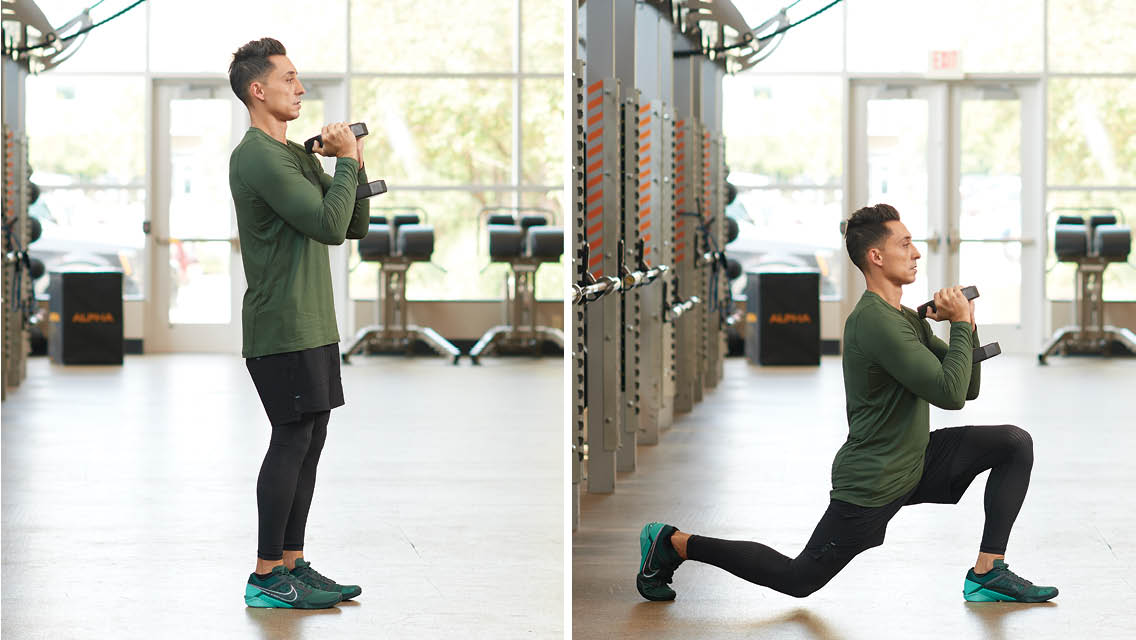
- Stand with feet about hip width apart and hold a dumbbell goblet-style, grasping one end with both hands at chest height.
- Keeping your chest proud and shoulders squared over your hips, step backward with one foot.
- Lower until your front knee forms a 90-degree angle. (Adjust the length of your stride as needed.)
- Keep your front knee in line with the middle toe of that leg. Your back knee can graze the floor but take care not to relax at the bottom of the move.
- Reverse the movement by stepping your rear foot back to the starting position.
- Perform 12 to 15 repetitions on the same side, then repeat with the opposite leg.
5. Seated Leg Extension
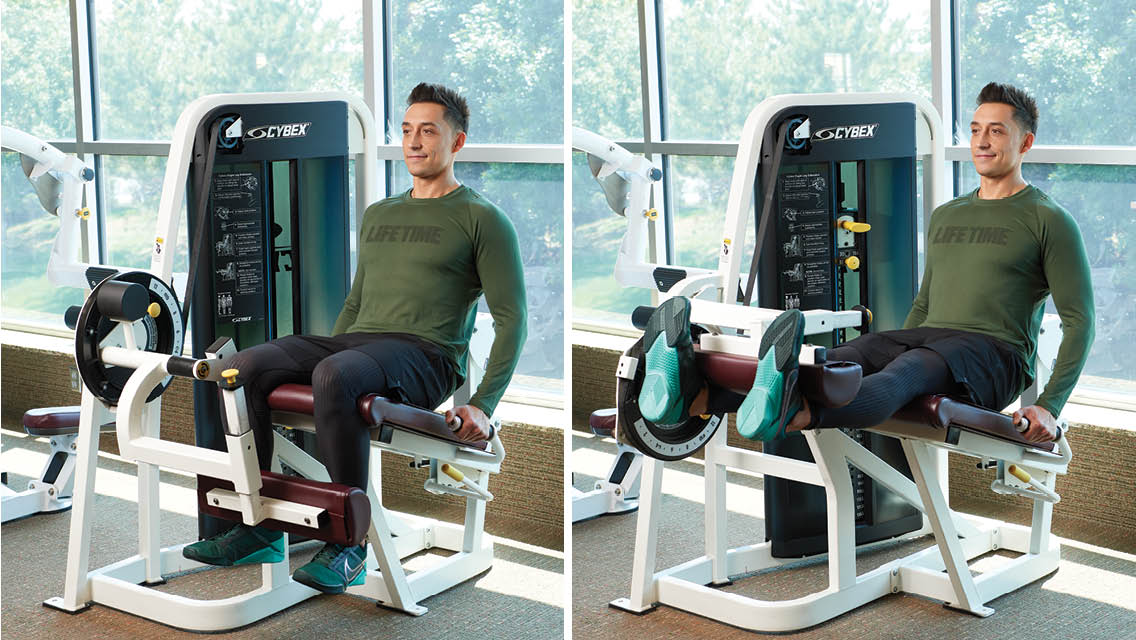
- Sit at a quad extension machine and adjust it accordingly to ensure your knees are next to the hinge point on the machine (on Life Time equipment, this is indicated by a red dot). Put your legs behind the leg bar to ensure the shin padding is directly in front of your ankles. Set the machine to a light weight that you can perform for sets of at least 12 reps.
- Grab the side handles and lift your legs to extend them forward, taking a quick pause at full extension. Make sure to keep your glutes on the seat.
- Lower with control, then repeat.
- Repeat for the desire number of repetitions, taking care not to rush the reps.
6. Prone Hamstring Curl
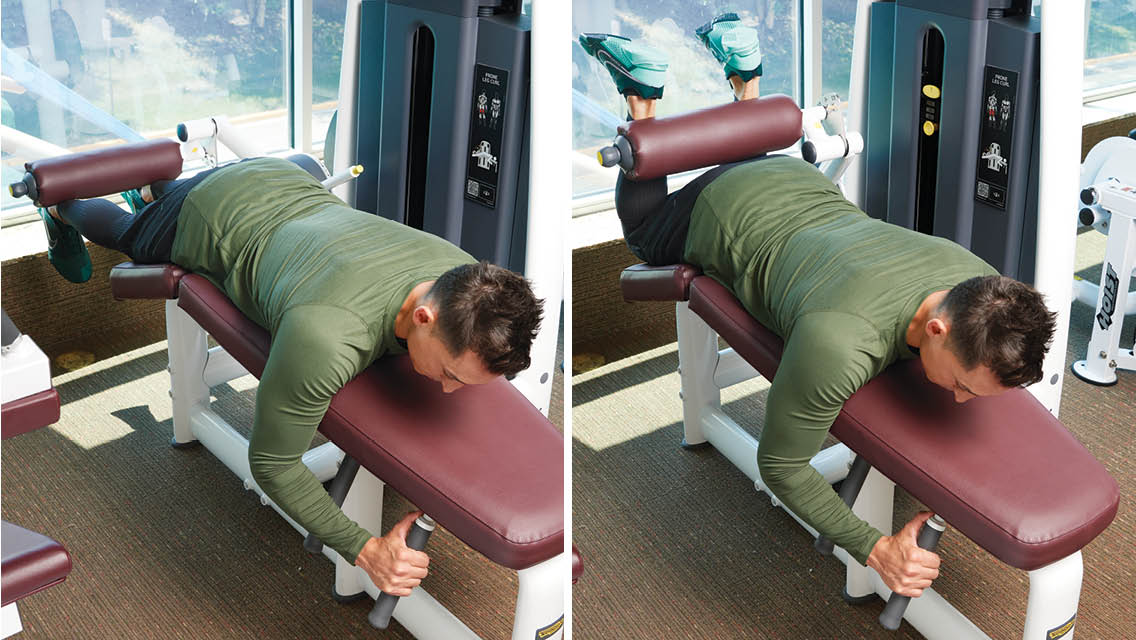
- Lie face down on the leg curl machine. Grasp the support handles on either side of you and extend your legs fully to start. You’ll want the roller pad to rest on your lower calves, above your heels and ankles.
- Actively press your hips into the bench and bend your knees to draw your feet as close to your glutes as you can.
- Pause for a moment then extend your legs and return your feet to the starting position with control.
- Repeat for 12 to 15 repetitions.
How Much Weight Should I Lift?
The cardinal rule for weight selection is that, once you’re comfortable with an exercise, you should choose a weight that’s challenging — but not impossible — to lift with good form for the prescribed number of reps.
- “Heavy” weights are typically loads you can lift fewer than eight times with good form.
- “Medium” weights are typically loads you can lift eight to 12 times.
- “Light” weights are typically loads you can lift 15 or more times.
Because this program calls for a rep range of 12 to 15, you’ll likely be using weights on the upper end of “light” to lower end of “medium.” Exactly what this means may take some trial and error when beginning the program, and especially if you are a newer lifter. Begin conservatively, then increase weight progressively as your strength increases and form improves.
This article originally appeared as “Split Level” in the November 2022 issue of Experience Life.
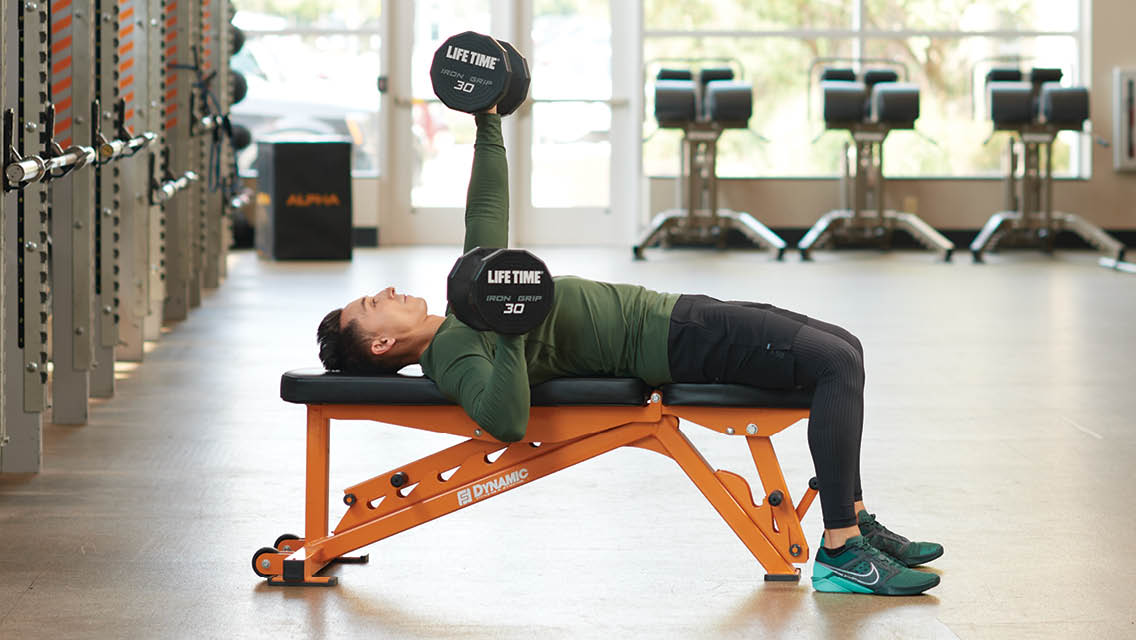

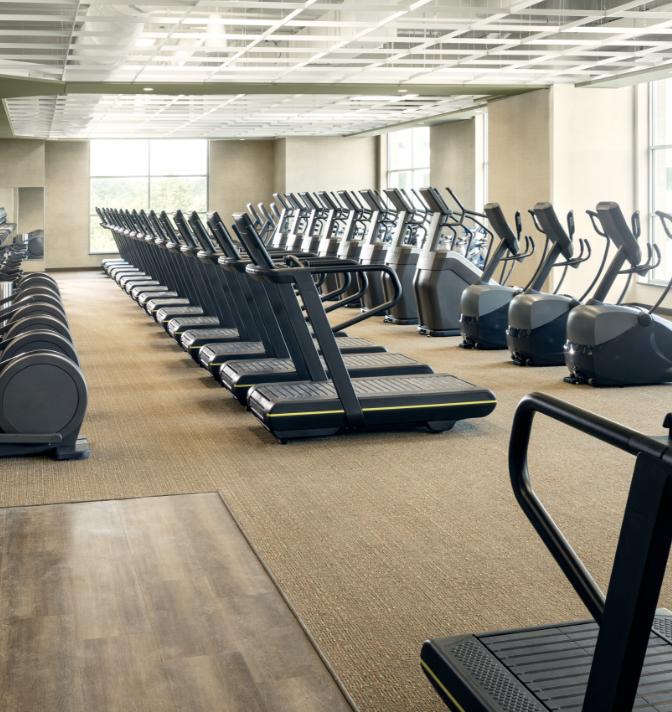
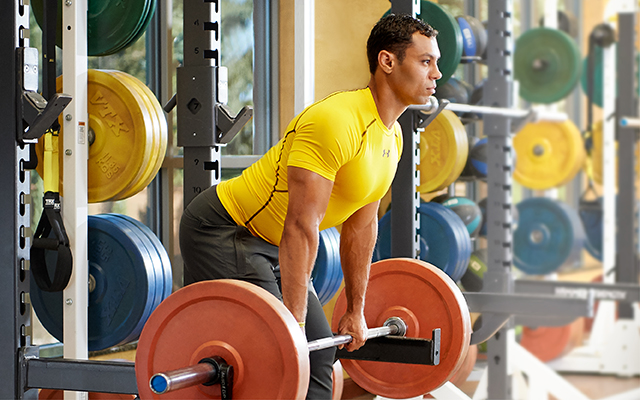
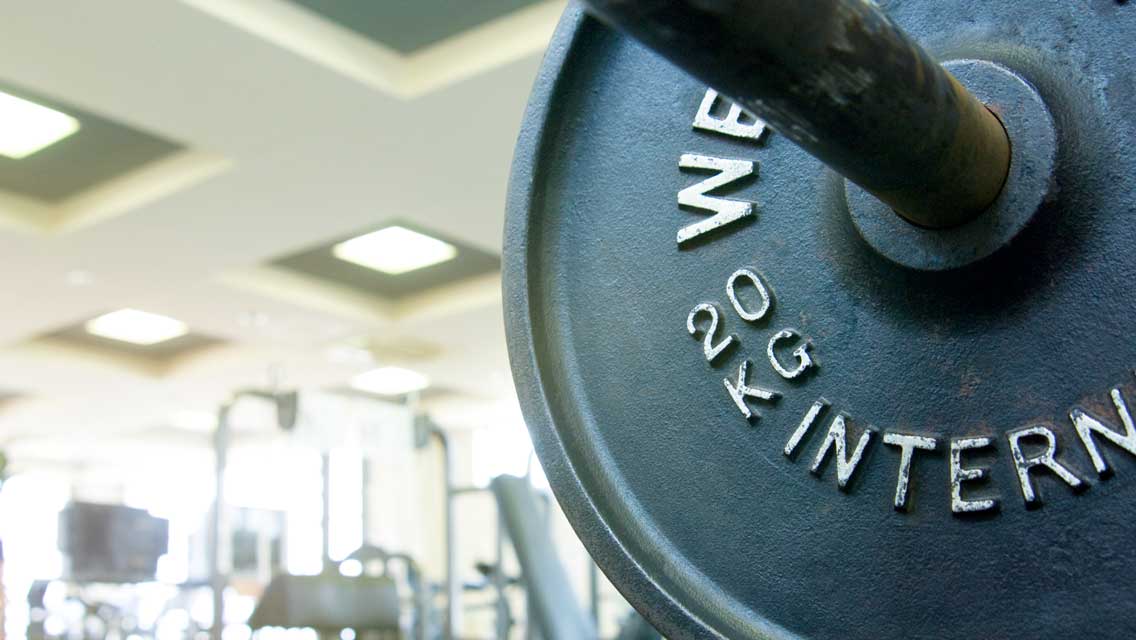
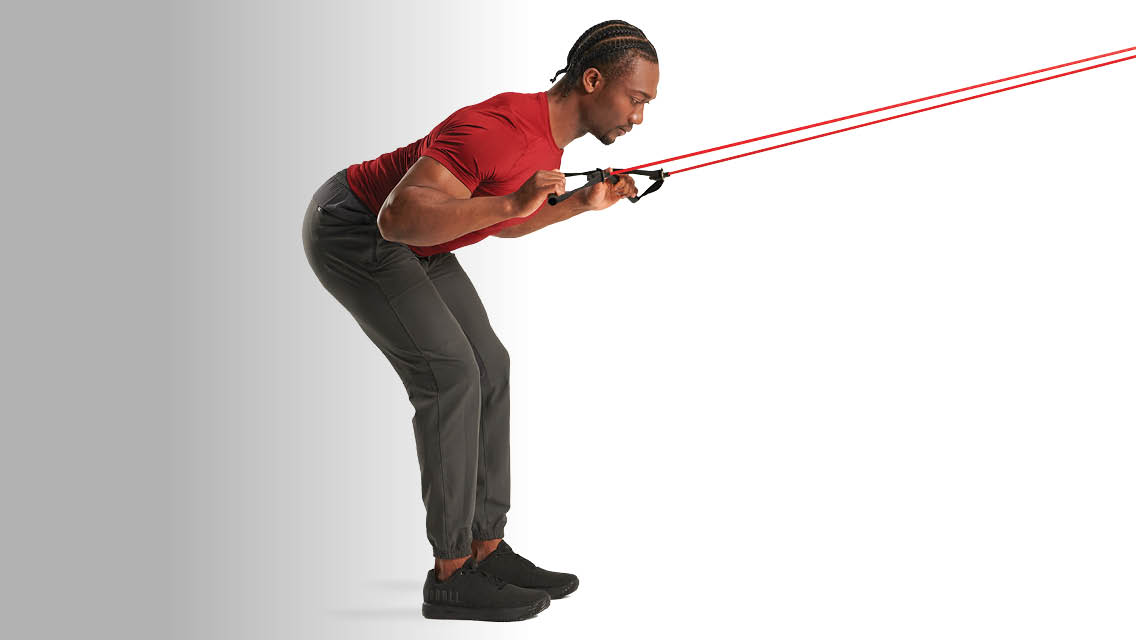
This Post Has One Comment
This is an excellent article!! I’m a Masters runner who includes strength training and body-weight and mobility exercises weekly. The ‘split’ program you describe (with good photos!) has been the routine that works best for me. Thank you!